Lighting Ideas to Transform Your Home: Style, Mood & Practical Tips
Discover stylish lighting ideas to transform every room. Learn how to layer ambient, task & accent lighting for comfort, mood, and modern home style.
Lighting can seriously transform how your home feels, showing off your style while making everyday living more comfortable. Swapping out tired fixtures or just getting creative with bulbs and placement can breathe new life into any space, and you can do it all without grabbing a sledgehammer for renovations. I’ll share some of my favourite lighting ideas and tricks for every room, blending cool style with actual usefulness.
Hello & welcome, my passion for interior styling began when we moved into our Georgian home and I set out to transform its plain walls into colourful, character-filled spaces. Over the years I’ve fallen in love with bold paint choices, thoughtful lighting, and accessories that highlight a home’s natural charm. Now I share simple, inspiring décor ideas to help others create rooms that feel warm, personal, and beautifully unique.
Garden Nest Living grew from a simple idea: to share my love of gardens and creating calm, beautiful spaces, both inside and out. When you buy through my affiliate links, you are allowing me to keep sharing inspiration, ideas and products… at no extra cost to you. Thank you for being a part of my journey!
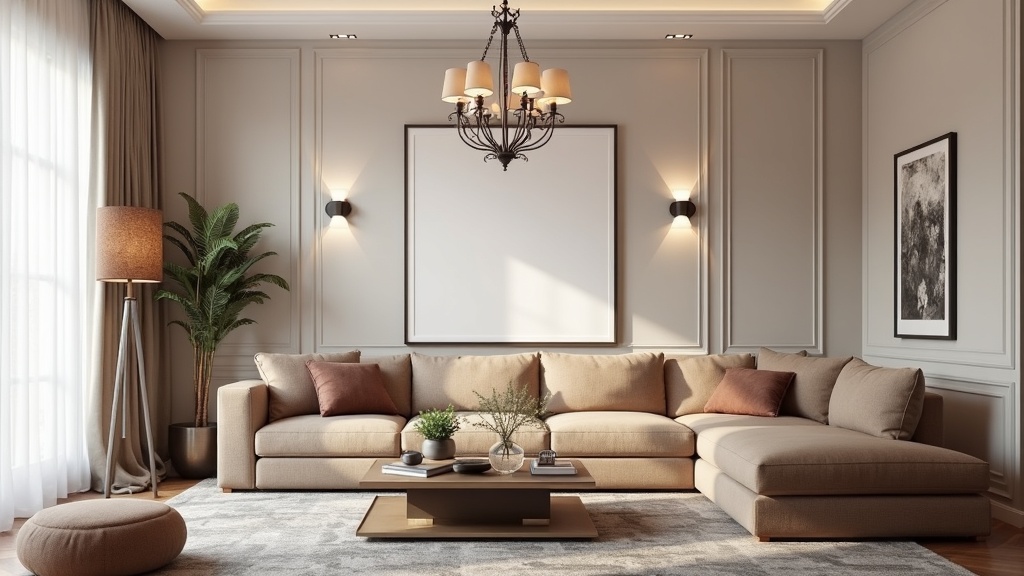
Why Lighting Matters in Home Décor
How Lighting Shapes Mood and Atmosphere
Lighting has a huge influence on the way your home looks and feels. Whether you’re after a cosy vibe or something crisp and modern, the right lighting gets you there. It’s not only about brightness; it’s about mixing up different types of lighting (like ambient, task, and accent) to create depth and character in every corner.
Balancing Style with Everyday Functionality
Modern lighting usually means fixtures with clean lines and geometric shapes, but there are lots of ways it fits with almost any décor style. A simple fixture swap can totally update a room that once felt stuck in another decade. If previous homeowners left some “legacy lighting” behind, new lights are an easy, affordable fix.
The Power of Layered Lighting (Ambient, Task & Accent)
Using a mix of ambient, task, and accent lighting gives spaces real depth, and I’m always surprised how quickly a layered lighting plan can switch up a room’s mood. Here’s a quick breakdown:
Ambient Lighting: The Foundation of Every Room
This is your main source of lighting, the ceiling lights or big fixtures that fill in the basics.
Task Lighting Ideas for Kitchens, Bedrooms & Offices
This is the practical lighting, like undercabinet lights in the kitchen or a reading lamp beside your bed.
Accent Lighting to Highlight Artwork & Features
This lighting highlights the good stuff—art, unique walls, plants, or display shelves.
Mixing all three keeps a room from feeling flat and lets you adjust the vibe for whatever you’re doing. For example, an open-plan living space feels more interesting and flexible with a mix of ceiling lights, a couple of floor lamps near the sofa, and a few undercabinet strips in the kitchen area.
John Cullen Lighting has a really useful and detailed article on how to use Ambient, Task & Accent Lighting.
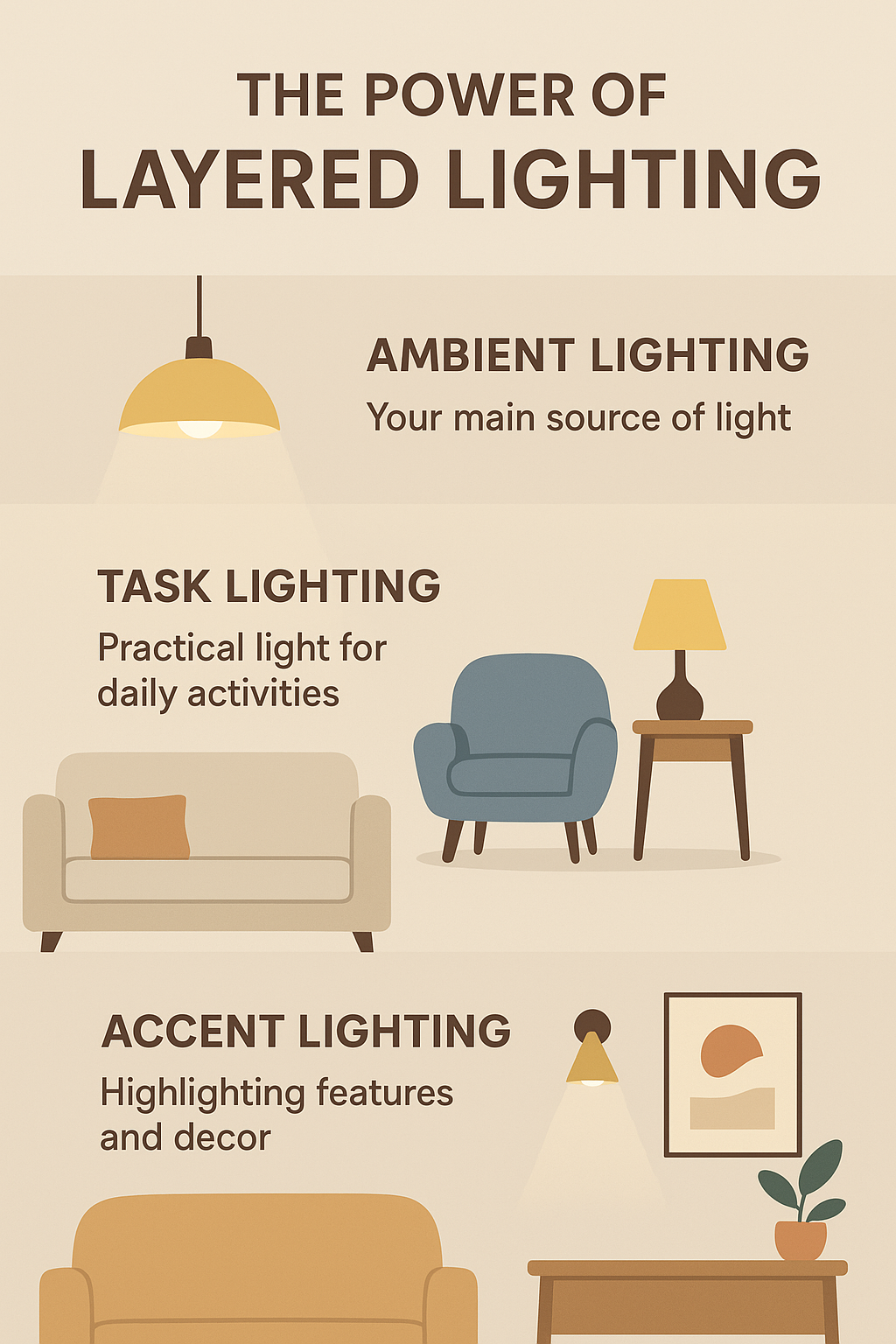
The Importance of Lighting in Home Décor: Style Meets Function
Lighting was something I never really gave much thought to in the past. For me, it was simply a practical necessity—I’d switch on the main light when it got dark and keep a bedside lamp for reading before bed. It wasn’t until we moved into our Georgian home and started researching interior design that I realised just how important lighting is—not only for functionality but also for creating atmosphere and style.
In the kitchen, I had always relied on the overhead lights when cooking or preparing for the next day. But in the evenings, when you don’t want harsh lighting yet still need some visibility, those bright main lights can feel overwhelming. Our solution was simple but effective: LED light strips fitted under the wall cabinets. They provide the perfect glow for making a cup of tea or grabbing a late-night snack without flooding the whole room with light.
One of my favourite lighting additions is a beautiful lamp that sits on our hallway sideboard. Every evening at dusk, I switch it on, and it instantly creates a warm, welcoming glow. It’s amazing how such a simple piece can transform the space, making it feel cosy and inviting as we wind down for the night.
It’s only when you start to think about how style and functionality work hand in hand that you begin to see what lighting can really do for your home. From practical kitchen lighting to mood-enhancing lamps, the right choices can completely change the way a room looks and feels.
Not sure where to look for lighting? Barker & Stonehouse, The White Company and Cox & Cox have some great options for lighting; lamps, lampshades and outdoor lighting.
If you are looking for a more affordable option to style your home, check out Wayfair.
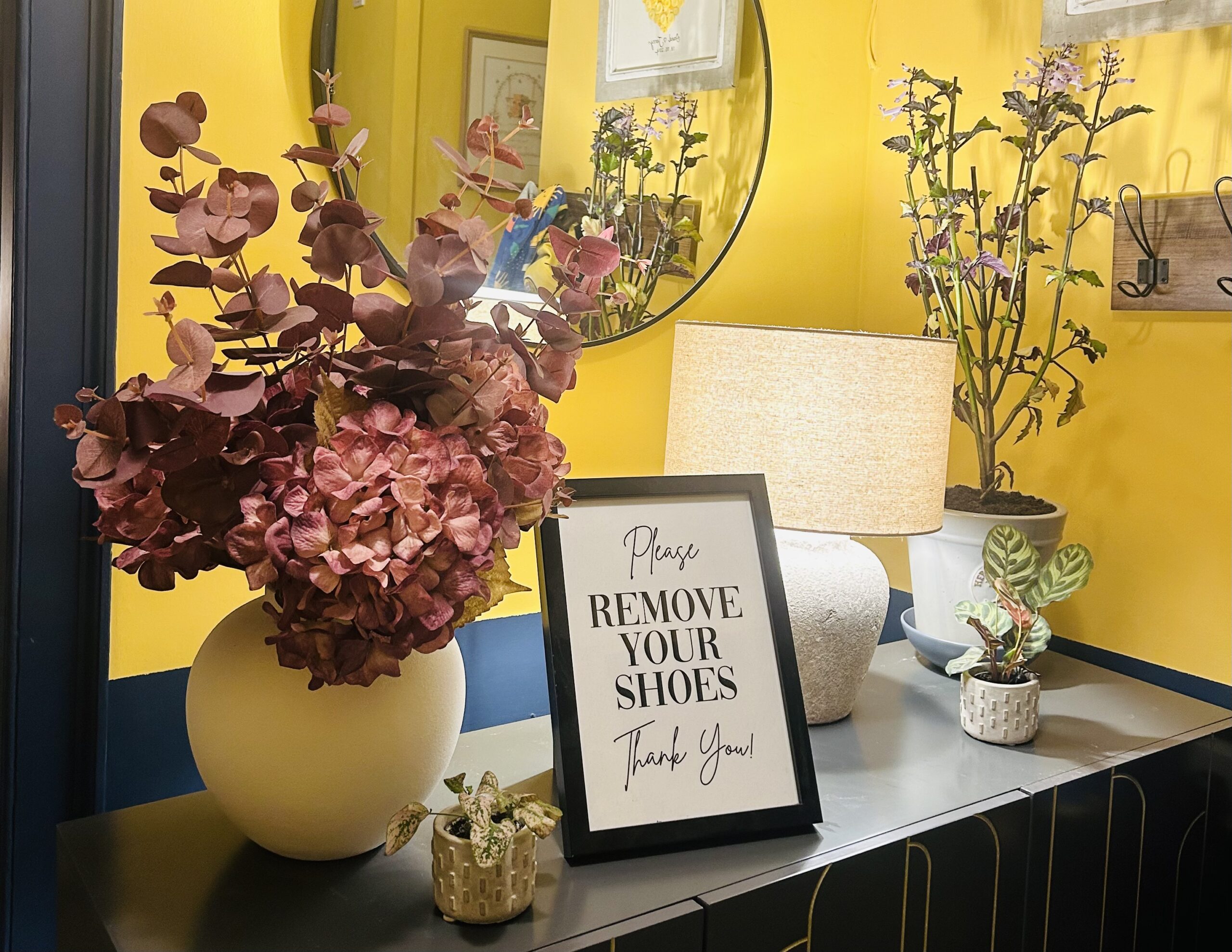
Choosing the Right Bulbs & Colour Temperatures
Warm White vs Cool White Bulbs: Which Works Best?
Choosing between warm and cool lighting is a game-changer.
Warm White Bulbs (2700K–3000K)
: These bulbs give off a soft, yellowish glow that instantly feels cosy and inviting, making them ideal for bedrooms and living rooms where comfort is the main priority.
Cool White Bulbs (4000K+)
Cooler tones create a brighter, crisper light that works especially well in offices, bathrooms, or modern interiors where you want a fresh, clean look and a more energising atmosphere.
Mixing Colour Temperatures Without Overwhelming a Space
While it’s possible to combine warm and cool lighting in the same room for creative effects, sticking to a single temperature per area usually helps the space feel more cohesive and visually balanced.
How Dimmer Switches Change a Room’s Vibe
Installing dimmer switches gives you flexibility, allowing you to easily shift the mood of a room from bright and energetic to soft and mellow without changing fixtures or bulbs.
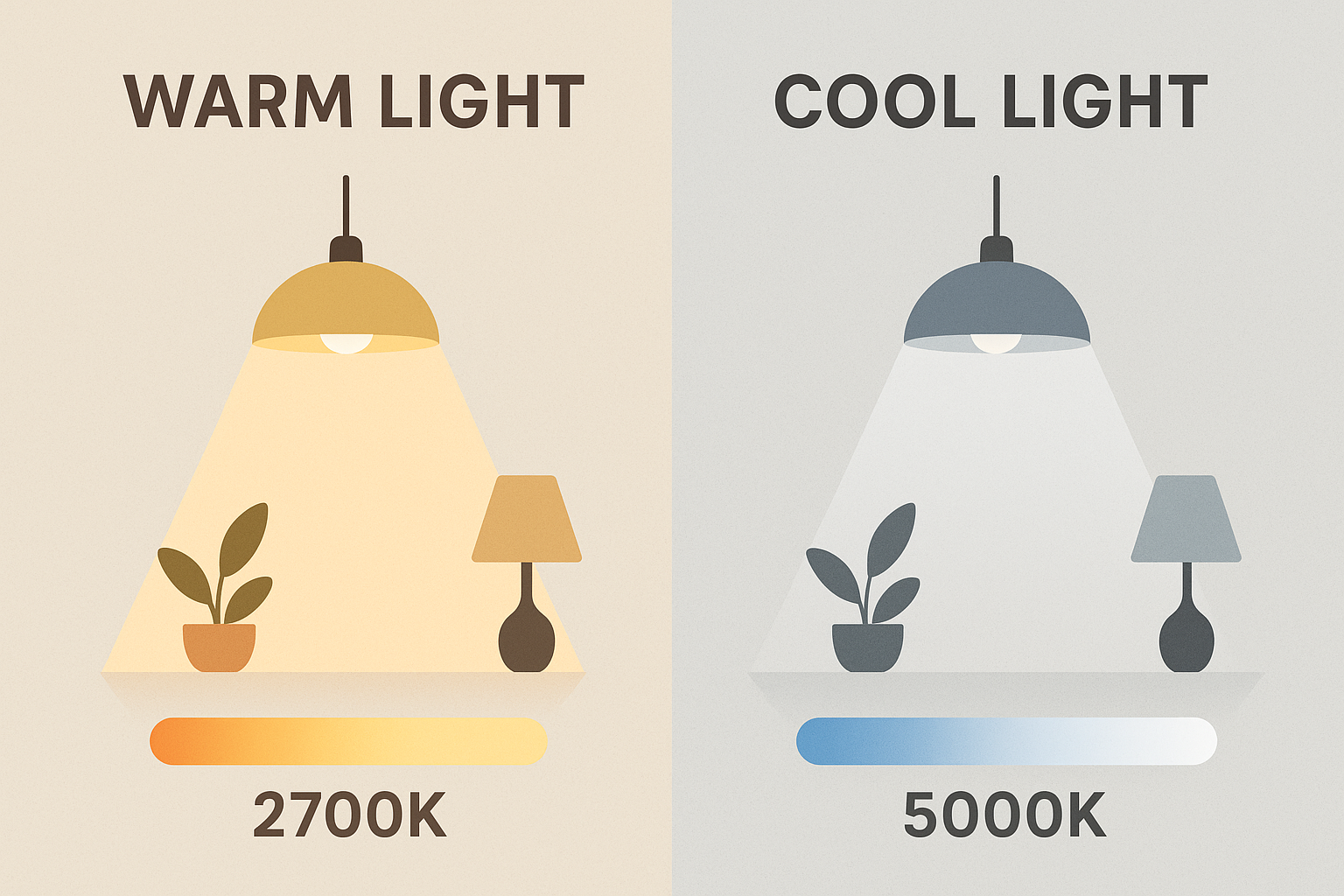
Room-by-Room Lighting Ideas
Living Room Lighting: From Statement Chandeliers to Cozy Corners
Layered Lighting is Key
Combine ceiling lights, wall sconces, floor lamps, and table lamps to create a flexible and balanced lighting scheme for different activities.
Statement Pendants or Chandeliers
Adding a dramatic chandelier or pendant serves as a focal point and elevates the overall style of the living room.
Wall Sconces for Depth
Layering wall sconces adds ambient light and creates a relaxed, cosy atmosphere.
Task Lighting
Place table or floor lamps near sofas and chairs to provide focused light for reading, conversation, or hobbies.
Dimmer Switches
Installing dimmers allows you to quickly adjust the brightness, making it easy to transition from lively daytime gatherings to relaxed evening lounges.
Flexibility & Mood
Using multiple lighting types ensures the space can adapt to everyday living, entertaining, or quiet relaxation without feeling flat or one-dimensional.
Bedroom Mood Lighting for Relaxation and Comfort
Prioritise Comfort
The bedroom should focus on creating a calming and restful atmosphere.
Warm Bulbs
Use warm white bulbs (around 2700K) to provide a soft, relaxing glow that promotes relaxation.
Balanced Fixtures
Opt for streamlined lamps or wall lights on either side of the bed, avoiding fixtures that are too bold or overly bright.
Task Lighting for Reading
If you read in bed, include a focused task lamp and ensure overhead lights are dimmable to prevent harsh lighting at night.
Layered Lighting & Blackout Shades
Combine multiple layers of soft lighting with blackout shades to enhance comfort and support restful sleep.
Kitchen Lighting Ideas: LED Strips, Pendants & Under-Cabinet Solutions
Prioritise Safety & Functionality
Good lighting is essential in kitchens to ensure safe and efficient food preparation while also adding style.
Pendant Lights
Hanging pendants over the island provides focused task lighting while serving as a stylish design feature.
Undercabinet LED Strips
These lights are perfect for illuminating countertops, making cooking and prep tasks easier and more precise.
Ceiling Lighting
Use a bright but not-too-harsh ceiling light to provide overall coverage for the entire space.
Smart Bulbs & Dimmers
Installing smart bulbs or dimmers allows you to adjust lighting levels easily, from meal prep to dinner parties, without changing fixtures.
Open Shelving Accents
Add puck lights under open shelves to highlight dishes and glassware, creating a designer look without a high cost.
House Beautiful have a great article on Kitchen Lighting ‘These Are the Types of Lighting Every Kitchen Needs’
Outdoor Lighting Ideas to Extend Your Living Space
Extend Your Living Space
Well-placed outdoor lights allow you to enjoy patios and gardens long after sunset, effectively expanding your usable living area.
String Lights & Lanterns
Decorative options like string lights or lanterns create a fun, inviting atmosphere for evening gatherings.
LED Uplights & Pathway Lighting
Use LED uplights along fences or pathways to highlight garden features while improving visibility and safety.
Subtle Security Lighting
Opt for sleek solar-powered lanterns or motion-sensor garden stakes instead of harsh floodlights to maintain style without compromising security.
Layered Lighting Effects
Combining different types of outdoor lighting—ambient, task, and accent—enhances depth, highlights key areas, and makes outdoor spaces feel more dynamic.
Energy Efficiency
Modern outdoor lighting options, such as LEDs and solar-powered fixtures, provide stylish illumination while saving energy and reducing costs.
Smart vs Traditional Lighting: Pros & Cons
Best Smart Lighting Options for a Modern Home
Smart bulbs, app-controlled switches, and voice-activated setups are ideal for anyone who enjoys adjusting lighting for different moods and occasions.
With smart lighting, you can easily change brightness, warmth, or even colour directly from your phone or with a quick voice command to your smart home hub.
This flexibility is especially useful for moments like movie nights, hosting parties, or creating a calm atmosphere as you wind down in the evening.
Many smart lights allow scheduling routines, such as gradually brightening in the morning to wake you up gently or fading into warmer tones at night to help you relax.
Beyond convenience, smart lighting feels futuristic while still being practical, and most modern smart bulbs are designed to fit into your existing fixtures without requiring a complete electrical overhaul.
When Traditional Lighting Still Works Best
Simple and fuss-free: Sometimes it’s nice just to flick a switch without needing an app or Wi-Fi connection.
Budget-friendly choice: Traditional bulbs and fixtures are usually cheaper upfront, making them great for quick, affordable updates.
Always reliable: Even if the internet goes down or tech plays up, your lights still work every time.
Great for guest rooms or rentals: Not every space needs smart features—traditional lighting keeps things easy for everyone to use.
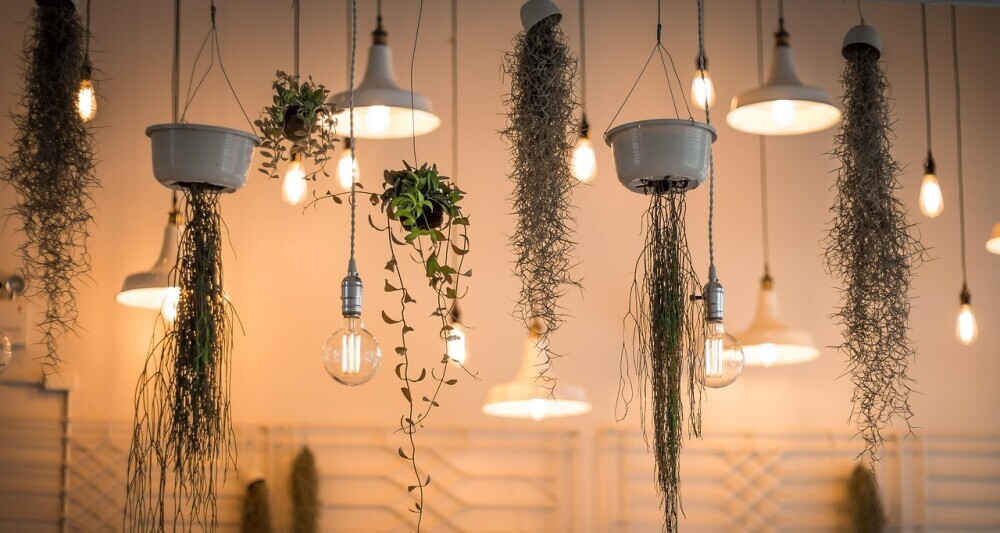
Common Lighting Challenges & Quick Fixes
Fixing Dark Corners with Accent Lighting
Dark Corners: Place compact LED spotlights or directional floor lamps in corners to brighten shadowed areas without cluttering the space.
Small or Awkward Spaces: Use wall sconces, uplights, and reflective surfaces like mirrors to make rooms feel larger and more inviting.
Reducing Glare and Eye Strain with Diffusers
Glare and Eye Strain: Layer bulbs at different heights and use diffusers or lampshades to spread light more gently and reduce harsh glare.
Updating Outdated Fixtures on a Budget
Old or Outdated Fixtures: Replace faded lampshades, yellowed covers, or outdated bulb shapes to instantly modernise your lighting setup.
Lack of Control: Install plug-in dimmers, smart plugs, or remote controls to adjust lighting levels easily without rewiring or replacing fixtures.
Lighting Comparison Guide
| Feature | Warm Bulbs (2700K–3000K) | Cool Bulbs (4000K+) | Smart Lighting | Traditional Lighting |
|---|---|---|---|---|
| Look & Feel | Soft, cosy, relaxing glow | Bright, crisp, energizing | Customizable (colour, dimming, scheduling) | Fixed brightness & colour |
| Best For | Bedrooms, living rooms, dining areas | Kitchens, bathrooms, offices | Any room where flexibility matters | Basic setups, rentals |
| Mood/Atmosphere | Warm, welcoming, intimate | Fresh, clean, modern | Adjustable for any mood or event | Static – one setting only |
| Control | Standard switch/dimmer | Standard switch/dimmer | Controlled via app, remote, or voice | On/off switch only |
| Energy Efficiency | High (LED warm bulbs) | High (LED cool bulbs) | Very efficient (especially LED smart bulbs) | Depends on bulb type |
| Cost | Affordable | Affordable | Higher upfront, long-term savings | Low upfront, no smart features |
| Extra Benefits | Easy on eyes at night | Boosts alertness & focus | Routines, remote access, colour-changing options | Simple & widely available |
Budget-Friendly vs. Splurge Options
Lighting Ideas by Budget: From Affordable Updates to Statement Fixtures
| Budget Tier | Examples | Best For | Style Impact | Notes |
|---|---|---|---|---|
| Under £50 | – Plug-in table lamps – Battery LED puck lights – Stick-on under-cabinet strips – Decorative bulbs (Edison, globe, smart starter kits) |
Renters, quick refreshes, small rooms | Subtle upgrades, adds mood lighting | Affordable, easy DIY, no electrician needed |
| £50–£150 | – Floor lamps – Pendant lights – Wall sconces – Smart bulbs & dimmer kits |
Living rooms, bedrooms, kitchens | Mid-range upgrade with noticeable style change | Mix of function + style without overspending |
| £150–£500 | – Designer pendants – Layered lighting systems – Outdoor string lights with smart controls – High-end task lamps |
Feature rooms, open-plan spaces, entertaining areas | Strong design statement, elevates décor | Some installation may be required |
| Splurge (£500+) | – Statement chandeliers – Custom built-ins – Integrated LED shelving – Architectural lighting plans |
Whole-home design, luxury projects | Transformative, architectural impact | Long-term investment, often requires professional installation |
FAQs About Home Lighting
Here are some common questions about home lighting and my straightforward answers.
Question: Does Lighting Really Change the Look of a Room?
Answer: Absolutely. Lighting affects how spacious, cosy, or lively a room feels. It also highlights the best architectural features and controls mood more subtly than almost any other design element.
Question: Easiest Lighting Upgrades for Beginners?
Answer: Swapping out bulbs for warm or cool tones and adding plug-in lamps. If you only make one change, try installing a dimmer switch.
Question: How to Match Lighting Fixtures to Your Home’s Style?
Answer: Match fixture shapes and finishes to your current hardware or furniture, then add a statement piece (like a bold pendant or fun lamp) for variety.
Question: Any tips for making small rooms feel larger with lighting?
Answer: Use uplights and wall sconces to stretch the space vertically or horizontally, choose lighter shades, and maximise daylight with mirrors or sheer curtains.
Question: Are there stylish options for outdoor security lighting?
Answer: Yes; look for motion sensor garden stakes, slim LED path lights, or solar-powered lanterns. They add both safety and curb appeal.
Final Thoughts: Let Your Style Shine with Lighting
My passion for styling began when we moved into our Georgian home over a decade ago. With its original features and quirks, it felt like the perfect canvas. At first, I played it safe with soft greys, minimal accessories, and modest lighting.
As my confidence grew, I experimented with richer colours, layered textures, statement rugs, curated shelves, and bolder lighting choices that reflected our personality. Today, deep, dramatic tones paired with plants, textiles, and mood lighting define our home. Farrow & Ball remains my go-to for paint—it always transforms a space.
The biggest lesson? There are no “mistakes,” only chances to refine and try again. Lighting is an easy way to refresh a room without remodeling. Layer, mix warmth and colour, and experiment with placement to instantly elevate everyday moments and gatherings. Light your home on your terms, and let your style shine.
Author Bio: Bold Interior Design & Decorating Ideas
My love for decorating and interior styling began over 12 years ago when we moved into our Georgian home. At the time, the walls were plain, beige, and uninspiring—but I knew I wanted to add colour, personality, and warmth to our living spaces.
I started with soft greys and lighter tones, but it didn’t take long for me to become braver with my choices. Soon, I was experimenting with bold feature walls to add vibrancy and contrast. Today, I absolutely love using deep, dramatic colours in every room, creating interiors that feel both stylish and full of character.
As my home decorating journey continued, I realised how important it was to research and plan carefully to create timeless spaces. A few years ago, Farrow & Ball was recommended to me, and their paint colours and wallpapers have been my go-to inspiration ever since. Their expert guidance and colour palettes have helped me transform our home while staying true to its historic charm.
Beyond paint and wallpaper, I developed a passion for choosing the right home accessories and lighting to elevate each space. With a Georgian property, I wanted to highlight original features rather than cover them, so every decision was made to enhance the natural character of our home.
Through years of trial, research, and inspiration from online resources, I’ve learned how to blend modern interior design with traditional architecture. That’s why I created Garden Nest Living—to share tips, decorating ideas, and styling advice so others can create homes that truly reflect their personality while embracing bold, beautiful design.
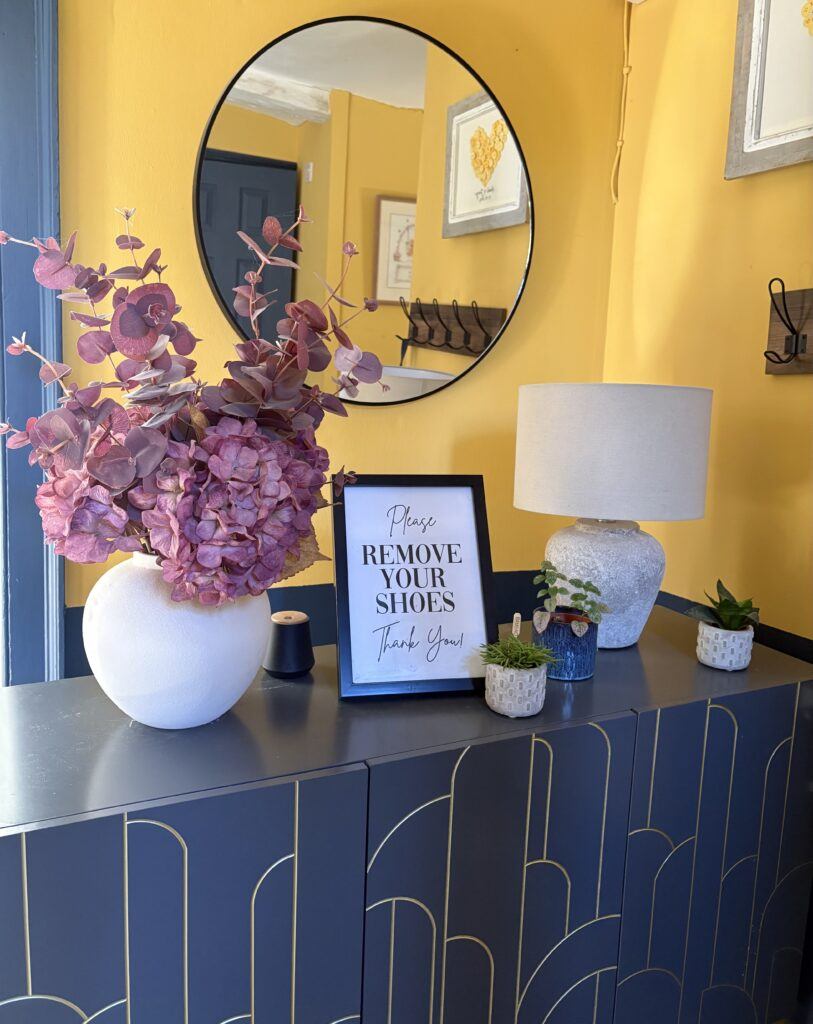
A stone lamp on the sideboard in our hallway, which gives a warm light in the evening once we have turned the main lights off.

I loved how this post showcases the power of thoughtful lighting to truly elevate a home’s style. You do a great job breaking down layered lighting—why ambient, task, and accent sources each matter—and showing how simple tweaks can transform a room from bland to beautiful.
One question: when blending warm and cool lighting for balance, do you have a go-to rule for mixing bulbs—like matching color temperature or using dimmers to shift mood? Also, for smaller spaces, have you found any lighting arrangements that help a room feel both cozy and open?
Thank you so much! I’m thrilled you found the breakdown of layered lighting helpful.
When blending warm and cool lighting, I usually aim to stay within a close range of colour temperatures—for example, pairing a 2700K ambient with a 3000K accent—so the mix feels intentional rather than jarring. Dimmers are fantastic for shifting mood, especially in living spaces or bedrooms.
For smaller rooms, I’ve found that using multiple light sources at different heights—like a combination of wall sconces, table lamps, and recessed lighting—helps the space feel cosy without shrinking it. Also, strategic placement near mirrors or reflective surfaces can bounce light around, making the room feel brighter and more open.
This post came at the perfect time for me! We’re on the finishing touches of our newly-built home, and my husband and I are in deep discussions about the lighting. I never realized how much of an impact it makes until now; it’s not just about brightness but about creating the right mood for each space.
I really appreciate your breakdown of ambient, task, and accent lighting. It gave me a clearer way to explain to my husband why I want layered lighting in the living room instead of relying on just one big fixture. I’m also torn between warm and cool bulbs for our kitchen—warm feels cozy, but cool seems more practical for cooking.
Do you think it’s okay to mix warm and cool lighting in different parts of an open-plan space, or is it better to stick with one for consistency? And if you could only splurge on one “statement” light, would you recommend it for the dining area or the living room?
Your tips have definitely made me more confident in our choices; thank you for sharing!
I’m so glad this post was helpful for you—congratulations on the new home, that’s such an exciting stage to be in! You’re absolutely right: lighting isn’t just about brightness, it really does set the mood and change how a space feels.
When it comes to mixing warm and cool lighting in an open-plan area, it can definitely work as long as you’re intentional. For example, cooler bulbs in the kitchen make food prep easier, while warmer lighting in the dining or living areas feels cosy and inviting. The key is to keep the colour temperature differences subtle—if one area is very cool and the other very warm, it can feel disjointed. Choosing bulbs that are close in tone (say, warm white in the living/dining and neutral/cool white in the kitchen) helps create flow without everything looking identical.
As for a statement light, if I could only choose one, I’d go with the dining area. It naturally draws people together, and a striking pendant or chandelier there becomes both a focal point and a conversation piece. The living room can then be layered with softer accent lighting and floor lamps to create atmosphere without needing a single “showstopper.”
I’m so happy to hear you feel more confident in your choices—lighting is one of those details that makes a huge difference once you’re living in the space.
Wow, I have to say I’ve never thought about lighting quite this much before, but everything you say here makes perfect sense. My husband and I have recently moved into a new place that is almost double the size of our old apartment (which was tiny, so that’s not saying much, but still). It’s a basement apartment, and I’ve been trying to think of ways to make it feel homier and more open. I never really thought that hard about lighting types! He does sometimes complain that our overhead living room lights are a bit harsh, so we’ve already considered changing them to a warmer/softer light. That’s about the extent of our discussion so far, but I think I’m going to screenshot your comparison charts and re-vamp our whole place.